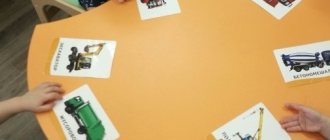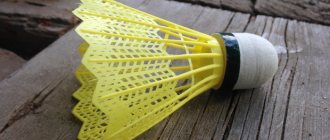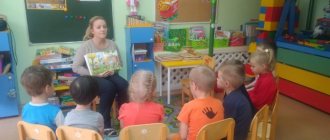Presentation of the educational field “Cognitive Development”
Elena Bogdanova
Presentation of the educational field “Cognitive Development”
Slide 1
I am Bogdanova E.V. teacher of the MBDOU “D/s “Malyshok”. My work experience is 33 years. I'm currently working in 2ml. group
Slide 2
I present to your attention a presentation of the educational field “Cognitive Development”
Slide 3
I would like to start my speech with the statements of famous people:
“The world surrounding a child is, first of all, the world of nature with an endless wealth of phenomena, with inexhaustible beauty. Here, in nature, is the eternal source of children’s intelligence.”
V. A. Sukhomlinsky
“Only that knowledge is lasting and valuable that you have acquired yourself, prompted by your own passion. All knowledge must be a discovery that you have made yourself.”
Korney Chukovsky
Slide 4
Cognitive activity is a conscious activity aimed at understanding the surrounding reality with the help of such mental processes as perception, thinking, memory, attention, speech.
L. S. Vygotsky wrote that mental development expresses something new that is accomplished independently through the new formation of new qualities of the mind and transfers mental functions from a lower to a higher level of development along the lines of voluntariness and awareness.
Slide 5
Relevance: Currently, there is an intensive development of preschool education in different directions: there is an increasing interest in the personality of a preschool child, his phenomenon, the development of his cognitive abilities, which ensure the formation of a holistic picture of the world. In a rapidly changing life, modern man needs not only possession of knowledge, but the ability to obtain it himself, operate with it, think independently and creatively. From birth, a child is already a discoverer, but he himself cannot always find answers to questions of interest. Preparing a child for research activities, teaching the skills of research, becomes the most important task of modern education. For the first time, the Federal State Educational Standard for Education identifies “Cognitive Development” as a separate educational area
Slide6
The goal and objectives are presented on the slide
Slide 7
The educational area “Cognitive Development” contains the following sections of work with children:
Familiarization with the subject environment
Development of cognitive, research and productive activities
Formation of elementary mathematical concepts
Introduction to the social world
Introduction to the natural world
Slide 8 -9
On this and the next slides you see the content of psychological and pedagogical work in five sections of the educational field “Cognitive Development” with children of the second junior group
Development of cognitive-research and productive (constructive) activities
Formation of elementary mathematical concepts
Formation of a holistic picture of the world, broadening one’s horizons
Subject and social environment
Getting to know nature
Slide 10
The educational area “Cognitive Development” successfully integrates with other educational areas:
Social and communicative development
Speech development
Artistic and aesthetic development
Physical development
Slide 11
Cognitive development is present in all types of children's activities
Slide 12
To implement the educational area “Cognitive Development” I use a wide variety of forms of work with children: in the main educational activities I continue to introduce children to their immediate environment, objects in their immediate environment, wild and domestic animals, we continue to get acquainted with color, shape, size, and so on. same with basic mathematical concepts. I also use the following forms of work: reading stories, conversations, discussing what we read, looking at story pictures, watching cartoons, presentations, role-playing games, didactic and theatrical games.
The implementation of educational activities occurs in the process of basic educational activities, during routine moments, during independent activities, in interaction with the families of students. In my work I use such forms of organization as: group, subgroup, individual.
Slide 13
In my work, I try to make maximum use of the authority of the family to consolidate knowledge in the educational field of “Cognitive Development”. Together with parents I conduct entertainment, consultations, surveys, and parent-teacher meetings.
slide 14
A very important condition for cognitive development is a subject-development environment. I pay great attention to creating a subject environment: the group is designed where the necessary gaming material for the development of sensory standards is concentrated. The group has attributes for role-playing games, didactic games and manuals. The kindergarten has a laptop and a multimedia installation, which makes it possible to use ICT in the implementation of the educational field “Cognitive Development”.
Slide 15
In accordance with the Federal State Educational Standard, the necessary conditions are determined for creating a social situation for the development of preschool children.
Slide 16
The following stages of cognitive development are distinguished: Curiosity, inquisitiveness, cognitive interest, cognitive activity
Slide 17
This slide shows the stages of a child’s understanding of the world. Memory, attention, thinking, imagination, sensation, perception lead to the formation of the sensory stage and the stage of logical cognition.
Slide 18 and 19
Here and on the next slide you see the necessary conditions for the formation of curiosity, cognitive interests of children, as well as pedagogical conditions for the successful and full intellectual development of preschool children.
Slide 20 - 21
The Federal State Educational Standard for Preschool Education presupposes the requirements of the basic educational program, which are presented in the form of targets and represent socially normative age characteristics of the child’s possible achievements at the stage of completing the level of preschool education. These slides show early and completion milestones. If we look carefully, these are the achievements that can be achieved by a child in the process of mastering the educational field “Cognitive Development”
Slide 22
on this slide you see some basic concepts of the Federal State Educational Standard for Education for the development of cognitive and research activities
Slide 23
You have now watched an integrated educational activity with children of primary preschool age
based on the fairy tale “Kolobok” using gaming and electronic educational technologies.
You can see the goals and objectives on the slide.
In the main educational activities, I used such methods and techniques as: gaming (finger gymnastics, outdoor game, didactic game) visual (multimedia presentation, verbal (story accompaniment for presentation, method of interest (travel to the forest, use of problem situations (questions, riddles, visual – auditory (listening to music)
In terms of content, OOD is integrated, since its parts are combined with knowledge from several areas. Problem solving is carried out through the following educational areas:
“Cognitive development” (teacher’s story, viewing a presentation, “Speech development” (finger gymnastics) “Social and communicative” (games, element of theatrical performance, “Artistic and aesthetic” (listening to music) “Physical development” (motor activity)
OOD begins with an organizationally motivated moment, where children’s attention is activated and maintained throughout the entire OOD. During the educational activity, children watched a multimedia presentation with narrated slides. The types of activities changed gradually. Children answered questions, played games, solved riddles, and met fairy tale characters. Children were active participants in playful moments during educational activities. Throughout the lesson, I used questions and tasks focused on the zone of proximal development (What to do? What do you think) Children stepped over an imaginary fallen tree. Answered provocative questions (how many ponytails do you have) Collected the picture and found the differences
This allowed us to maintain a positive emotional mood.
Thanks to the elements of theatrical activities, physical activity, gaming activities, and the use of ICT in the implementation of the educational field “Cognitive Development,” I was able to obtain a high-quality level of knowledge for preschoolers in this section. This type of work is carried out with younger children and will become more complicated over time.
Slide 24
In my work I use the following methodological support
Slide 25
Thank you for your attention!
Methodological techniques in teaching
When working with preschoolers, it is important to know that children learn information better if classes are conducted in a playful way - easy and fun. When preparing for a lesson, it is necessary to select interesting topics, make brief notes on classes, events and games, try to use various available ideas and materials from the environment, including the world of animals and flowers, construction objects and things. Natural elements and artistic materials allow children to develop their imagination and explore the nature of various objects that they see around them every day.
Cognition in kindergarten should be expanded through the following basic methods and forms:
- board and educational games;
- reading fairy tales and stories;
- observations;
- work assignments;
- role-playing games;
- construction games;
- individual work;
From group to group, the tasks become more complex and the techniques used expand. At any age, it is necessary to support the child’s research interest and activity.
In the younger groups, children get used to life in kindergarten. Children are taught to take an active part in activities and games. Their cognitive development in preschool educational institutions occurs through observations and organized games.
Cognitive development in the preparatory group
Children of the preparatory group and graduates are the pride of any kindergarten. How much work, love, patience and knowledge the teachers put into each child! Throughout the school year, cognitive development in the preparatory group becomes more complex and deepens.
By the end of kindergarten, children should have a desire to study at school and respect for their native language:
- a culture of behavior has been instilled between boys and girls, between children and adults;
- children should get acquainted with the pedigree and history of their family;
- know folk traditions, games, rituals, cuisine;
- be proud of your homeland.
Cognitive development of a preschooler within the framework of the Federal State Educational Standard for Education
Design and research activities
One of the main areas of cognitive development of preschool children is project activity in kindergarten.
The research method is the path to knowledge through independent creative, exploratory search.
Where to begin?
Together with the children, you need to choose a topic and draw up a work plan for the project. The topics of the projects should be appropriate to the age of the children, be interesting for them, and meaningful, so that every preschooler can find some aspect of interest to him in a given topic. Children, together with adults, determine interests within the topic and outline suggested sources of information.
Have you chosen a topic?
A problem is posed. It reflects a lack of knowledge on the chosen topic. As a result, children will jointly and independently find options and ways to solve the problem. At the same time, using the knowledge they already have, through trial and error, achieving real results.
Goals and objectives
give preschoolers an idea of the results of the project. A goal is an intended result. A task is a result defined by a deadline. The clearer you set tasks for your child, the easier it will be for him to plan his work on the project, complete it quickly and efficiently, and evaluate the success of the project. It is necessary to implement children's projects through different types of children's activities. It is also necessary to teach children to bring a started project to its logical conclusion.
At the end of the project
Children develop joy and pride in their work and the results obtained. It is imperative to give children the opportunity to present the result to the people around them - to present the project. The presentation of the project can be completed by making crafts, newspapers, books, or children can show and talk about their product of activity in the form of writing stories, entertainment and performances. In order for joint project activities between adults and children to be research-based, it is necessary to constantly support preschoolers’ initiative, curiosity and sustainable interest in the problem.
Constantly, as if playing, you need to introduce students to various situations that are accessible to their understanding. In order for the project method to be successful, it is necessary to discuss the step-by-step work with all project participants, select the necessary material and summarize the results of joint project activities. Design and research activities best contribute to the cognitive development of preschool children.
If a little person receives a comprehensive preschool education, in which cognitive development plays an important role in preschool age, then in the first grade he will easily cope with the new environment, requirements, and workload. He will be self-confident, independent and proactive. And this means a lot for a successful school life.
Interesting educational areas according to Federal State Educational Standards in preschool educational institutions
Phenomena of inanimate nature
For cognitive development in kindergarten, much attention must be paid to the conscious development of ideas about phenomena in inanimate nature, which makes it possible to clarify the patterns and relationships of various phenomena. There is no need to use complex, scientific phrases; it should be told in a language that is understandable and accessible to children.
- Do heavy or light objects sink in water?
- Why does a magnet magnetize?
- What is snow and ice and where do they come from?
- What happens if you bring snow into the house, and if you take it back outside?
- If the earth is round and spins, why don't we fall and fall off it?
This knowledge makes it possible to form the most basic knowledge of children about the composition of substances, about the states in which they are: hard, soft, free-flowing, viscous, floating, soluble, fragile. In older preschool age, children should receive initial knowledge about phenomena occurring in space, about the solar system and the moon.
Grouping Items
The ability to separate and group objects according to certain criteria is one of the most important basic cognitive skills. To teach children this, you can use a variety of objects - toys, kitchen utensils, food - and ask the kids to explain how they are different and how they are similar.
For example, they might say that both an apple and an orange are fruits, but an apple is red and an orange is not. Then offer other features for grouping - color, size, purpose.
If it is not possible to use real objects, take images, for example, special cards or cut out pictures from magazines.
Cause-and-effect relationships
Children love playing with water, but few of them notice that some objects sink in water and others do not. Younger children will definitely enjoy guessing which toys and objects will float and which will sink.
Use objects of different sizes and weights - a toothpick, a pebble, a plastic cup, a piece of paper. Be sure to explain to your children why some objects floated on the water and others did not, but first let them guess the reasons on their own.
Older children will appreciate a slightly different game: show how to make a boat out of clay or foil (which usually sink) that will float on the water. This way they will learn to connect cause and effect, and this skill will be very useful to them in the future.
Phenomena of living nature
Familiarity with natural phenomena is of great importance for the cognitive development of preschool children. The process of introducing preschoolers to the phenomena of living nature involves the child’s actions with real objects and phenomena. While studying material objects, their properties and relationships, the child constantly interacts with them. Thus, he will receive knowledge about this or that natural phenomenon not as a ready-made fact, but as a result acquired in the process of search and reflection. The phenomena being studied must not only be observed from the outside, but also be influenced by the child. The child must see, hear and modify these phenomena, identifying new properties and relationships in them.
A child learns new knowledge well, firmly and for a long time when he hears, sees everything himself and interacts with the subject being studied.
Children should be introduced to magnifying glasses, tweezers and other tools that will help them observe wildlife. During thematic lessons, you can draw their attention to the structure of flowers, the heterogeneous structure of stones, and the veins on the foliage of trees. Let them try to guess what certain parts of a plant or parts of an insect’s body are intended for, and how they are formed. It's amazing what original guesses they will sometimes make.
Cognitive development in the older group
The cognitive development of preschoolers according to the Federal State Educational Standard at this stage involves consolidating and expanding knowledge:
- about different subjects;
- about the seasons, their beauty and uniqueness;
- about natural phenomena, cataclysms, natural disasters;
- on the prevention of diseases, injuries, first aid;
- about safe handling of household appliances;
- about behavior on the street, with strangers, in transport.
Teachers interest children in different types of activities. These include sketches, games, and conversations. In a mini-study, a child can become a seed that has been planted, watered, and taken care of. And then the grain turned into a spikelet. There are no limits to imagination! The goal is to create a desire to invent in a child. But for this he must have a certain amount of knowledge. Therefore, cognitive development in the older group is intertwined with the development of speech, fiction and familiarization with nature.



